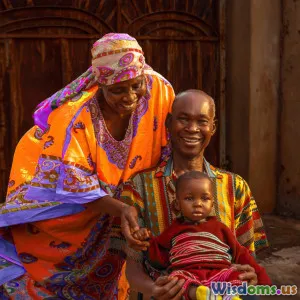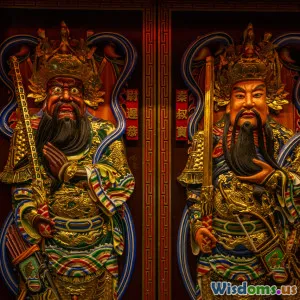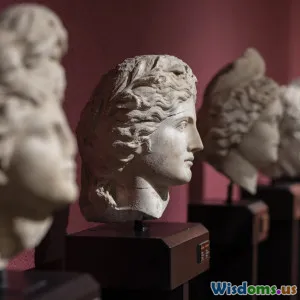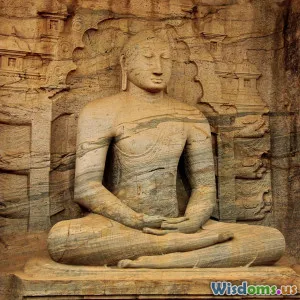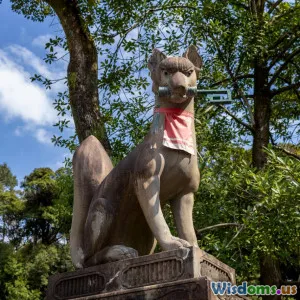
What Modern Writers Get Wrong About Ancient Japanese Spirits
8 min read Explore common misconceptions about ancient Japanese spirits and discover their true cultural significance beyond modern portrayals. (0 Reviews)
What Modern Writers Get Wrong About Ancient Japanese Spirits
Ancient Japanese spirits, or yōkai and kami, have captivated imaginations worldwide through books, movies, and anime. Often, these forces of Japan's rich spiritual heritage are reduced to mere monsters or caricatures. But what if those popular portrayals gloss over the deep cultural, religious, and philosophical roots these beings embody? In this article, we dive into common mistakes modern writers make about ancient Japanese spirits—and illuminate why understanding their authentic context matters.
Beyond Ghost Stories: Understanding the Spiritual Landscape of Japan
To truly grasp what many modern narratives miss, it’s essential first to differentiate key terms.
- Kami: Often translated as gods or spirits, kami are natural forces or phenomena that can inhabit objects, places, or even ideas. They don’t align perfectly with Western concepts of deities but more as sacred essences.
- Yōkai: These are creatures from Japanese folklore encompassing a wide range of supernatural entities—ghosts, demons, and spirits with unique characteristics.
Writers routinely confuse or conflate these categories, treating all ancient spirits as malevolent or whimsical monsters, flattening their complexity.
Misconceptions Modern Writers Perpetuate
1. Depiction as Evil or Malevolent by Default
Many stories, especially in Western-influenced media, paint ancient Japanese spirits as inherently hostile or terrifying. Yet this is an oversimplification.
For instance, Zashiki-warashi are childlike spirits who bring fortune and happiness to households, rather than harm. Conversely, Tengu—winged mountain spirits—are tricksters with complex roles: protectors of forests and sometimes punishing arrogance.
This duality is missing in narratives that reduce them to evil antagonists. Scholars like Michael Dylan Foster emphasize that yōkai reflect human traits and societal norms—serving as moral lessons rather than just villains.
2. Ignoring Shinto and Buddhist Interconnection
Ancient Japanese spirituality is heavily intertwined with Shinto and Buddhist beliefs. Modern writers often neglect this, treating spirits as isolated folklore elements instead of integral parts of religious life.
Kami, for example, are objects of ritual worship with shrines throughout Japan (the famous Ise Grand Shrine dedicated to Amaterasu being a prime example). Yōkai tales often carried Buddhist moral undertones, illustrating consequences of human attachment and selfishness.
Ignoring this religious symbiosis leads to a loss of narrative depth and cultural accuracy.
3. Oversimplifying Spirits as Universal or Identical Across Japan
Comparing Japanese spirits with Western ghosts or monsters results in generalized portrayals that overlook regional nuances. Ancient Japan’s geography and isolated communities led to diverse yōkai and kami traditions.
For example, the Kappa, a water spirit, varies greatly in characteristics and stories between regions—sometimes dangerous, sometimes mischievous. Writers who depict them as one-dimensional fail to capture this cultural richness.
4. Treating Spirits as Mere Entertainment Props
In some modern storytelling, spirits merely serve as aesthetic or horror elements without exploring their roles as cultural metaphors or spiritual entities. This diminishes the original intent where yōkai and kami played crucial roles in explaining natural phenomena, reinforcing community values, and linking humans to their environment.
Authentic Representation: A Path to Respect and Understanding
Deep Diving into Origins
Ancient Japanese spirits emerged from a worldview where nature and spirituality were inseparable. Kami animism expresses reverence for mountains, rivers, thunderstorms, and other natural forces.
Beyond scripts or novels, experiencing Japanese festivals like Obon, which honors ancestral spirits, reveals the living tradition behind these beliefs. Spirit myths are not stagnant folklore but evolving narratives reflecting human interaction with the unseen world.
The Power of Nuance in Characterization
Modern literature can learn from classical works. The 8th-century text Kojiki (Records of Ancient Matters) and Nihon Shoki reveal how spirits embody virtues, social order, and cosmic balance.
Yōkai like Nue, a chimera-like creature, symbolize chaos and disease but also the mysterious nature of the unknown—creating a metaphor rather than a simple “monster.” Incorporating such layers can enrich storytelling.
Consult Japanese Sources and Scholars
When writing about ancient Japanese spirits, consulting primary sources in translation and academic commentary ensures cultural integrity. Writers such as Shigeru Mizuki, a renowned manga artist, dedicated decades to documenting yōkai with appreciation and scholarship.
Respectful depiction emerges from acknowledging the spirits’ roles and symbolism rather than using exoticism or superficial thrills.
Real-World Impact: Why Correct Portrayals Matter
Cultural misunderstandings can perpetuate stereotypes and reduce richness to commercialized tropes. This matters beyond literature—tourism, education, and intercultural relations also hinge on respectful representation.
For example, misrepresenting kami as solely malevolent spirits could offend practitioners of Shinto who regard these beings with reverence.
Furthermore, authentic portrayals encourage curiosity, cross-cultural appreciation, and preservation of intangible cultural heritage, inspired by UNESCO’s efforts to protect folklore traditions.
Conclusion
Ancient Japanese spirits are more than ghostly myths or spooky villains; they are living embodiments of nature, morality, and human psychology developed over millennia. Modern writers face the challenge and opportunity to portray these beings authentically—honoring their complexity, cultural context, and spiritual significance.
By moving beyond caricature and researching deeply, storytellers can revitalize these spirits, providing audiences worldwide with not just entertaining tales but also meaningful connections to Japan’s profound cultural legacy.
Whether through literature, film, or gaming, the future of ancient Japanese spirit narratives shines brightest when grounded in respect, knowledge, and nuanced understanding.
References:
- Foster, Michael Dylan. Pandemonium and Parade: Japanese Monsters and the Culture of Yōkai. University of California Press, 2009.
- Smyers, Karen Ann. The Fox and the Jewel: Shared and Private Meanings in Contemporary Japanese Inari Worship. University of Hawaii Press, 1999.
- Mizuki, Shigeru. GeGeGe no Kitarō (Manga), which offers an extensive catalog of yōkai with respectful storytelling.
- Official website of Ise Grand Shrine https://www.isejingu.or.jp/en/
- UNESCO Intangible Cultural Heritage Profiles
Rate the Post
User Reviews
Popular Posts
















